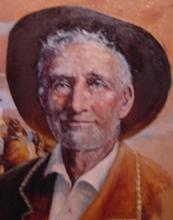

| Catalina Villarreal & Jessica Medina | Spring, 2006 |
| U.S. History 1302 | R. Hines, Instructor |
Joe Murphy was born in Big Foot, Texas. He graduated from Divine High School. During 36 years, he worked as a police officer on the State Police. In 1956, he married a girl from Big Foot. Bill Boyd's family came from Arkansas in the year of 1800. They worked to obtain land in Big Foot. He fought in the Korean War.
The father of the town is William Alexander Anderson Wallace, best known as "Big Foot." William Alexander A. Wallace was born in April 3, 1817. In 1937 he came to Texas to avenge the death of his brother. He became a Texas Ranger, Pony Express Rider from San Antonio to El Paso, and Indian Fighter. He was called Bigfoot because of his big feet. Wallace was imprisoned in Mexico and took part in the famous Mier Expedition, where beans were drawn from a bucket to determine which prisoners would live or die. He fortunately "drew deep" and got a white bean, saving his life. Bigfoot Wallace never married, and he spent his last years in Big Foot, and died January 7, 1899. He was buried at the Longview Cemetery, but was later moved to the State Cemetery at Austin, Texas.
There are many different stories about how Big Foot got its name. The most popular one being that Bigfoot Wallace had given 5 cents to a child and asked him to go to Connelly's Store and get him some chewing tobacco. On the way to the store the child dropped the coin in the sand and could not find it. The child went on to the store, telling of losing the coin the store owner told him it was alright and wrote on the wall Bigfoot- 5¢ and gave the child the tobacco. When the Postal Service came through recording the names of the towns, the Postal Worker went to the store and asked the name of the town. The store owner told him it had no name. The postal person saw the name written on the wall and said; "How Bigfoot?" the town was then named for then named for William Alexander Anderson Wallace, also known as "Bigfoot Wallace."
According with Mr. Murphy and Boyd actually are 200 people living in Bigfoot. When the Railroad (Union Pacific) came to Devine some people and business moved to Devine. Now there are two churches Catholic and Church of Christ. Cattle and oil are the main economic resources of the town. The town has its own water system and water supply. "There were rumors about a Color man that was hanged in a tree near the museum." Mr. Boyd said. He also said that the community of Bigfoot is really close; everybody helps each other out whenever they have trouble. The differences of the ethnics are more visible at the cemetery; according with Mr. Murphy many years ago the Hispanics and the Anglos used to bury in separated placed, and now is different everybody has the right to choose the land they want to rest.
The cemetery is one of the most important historical places in Bigfoot. Some heroes of Bigfoot were John M. Gude went to Civil war and he was a confederated soldier. James C. Stroud he was a confederated soldier 4TH reg. He was born in May 4TH 1833; he died on March 25, 1922. William Carvin Winter fought in the Battle of San Jacinto. He was born I Tennessee in 1809 and died in 1863.